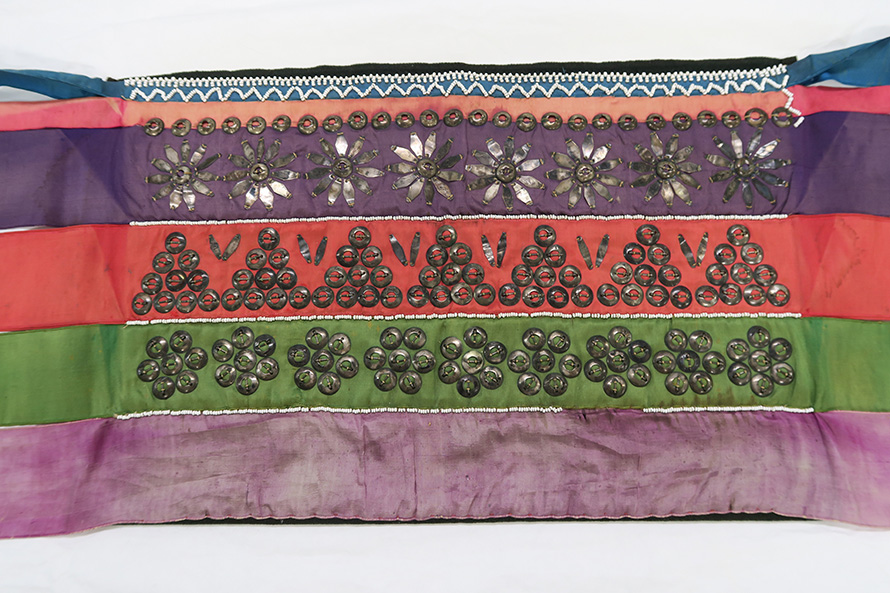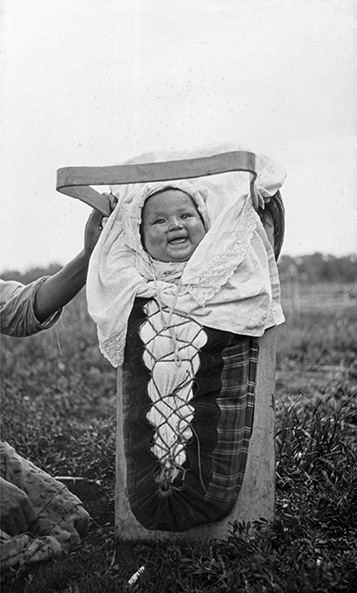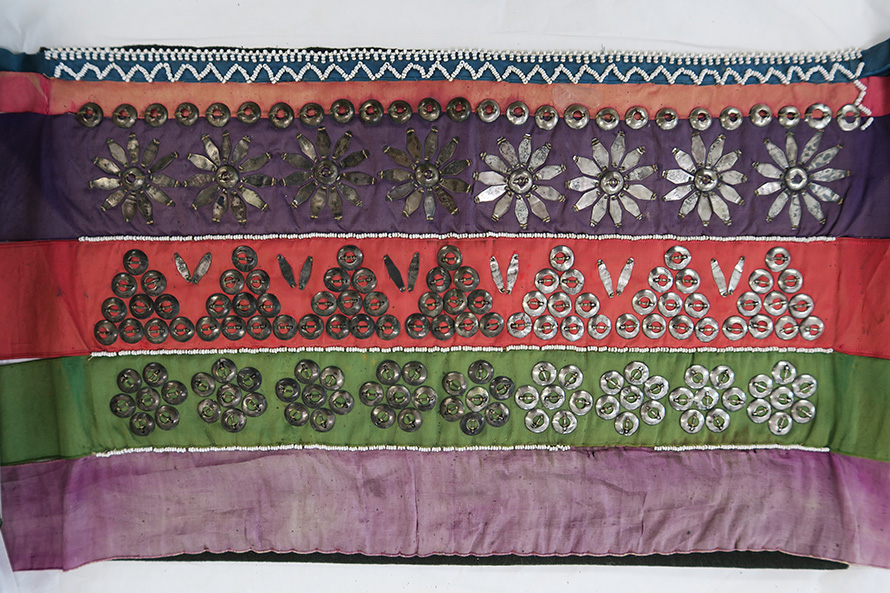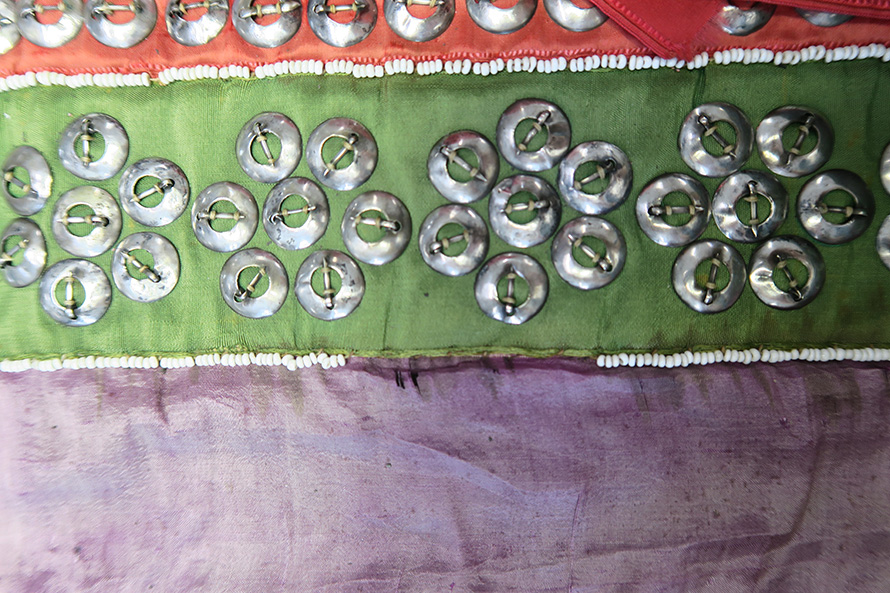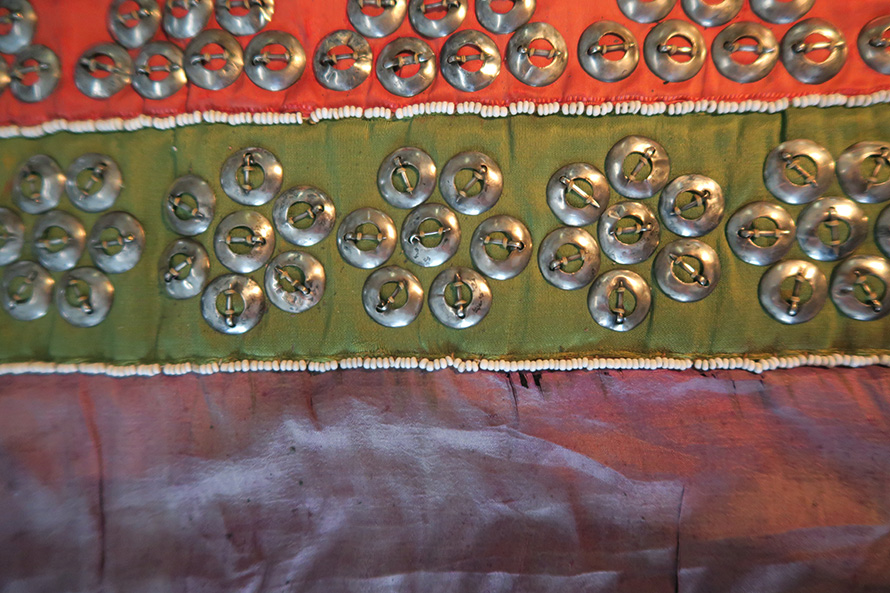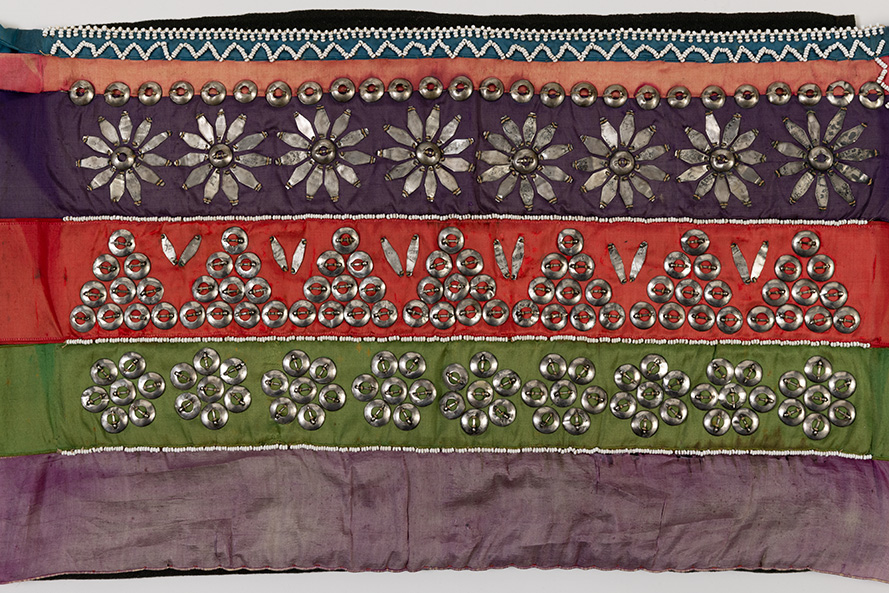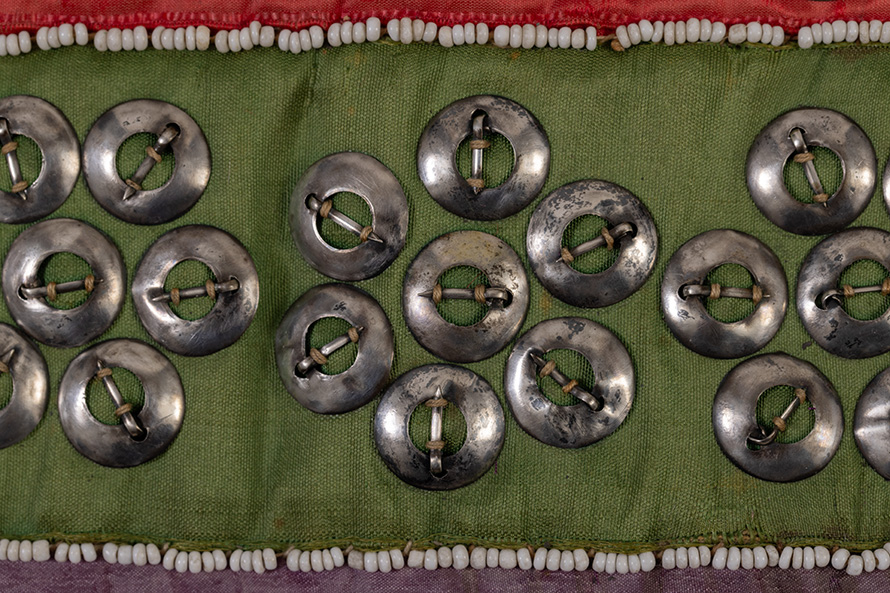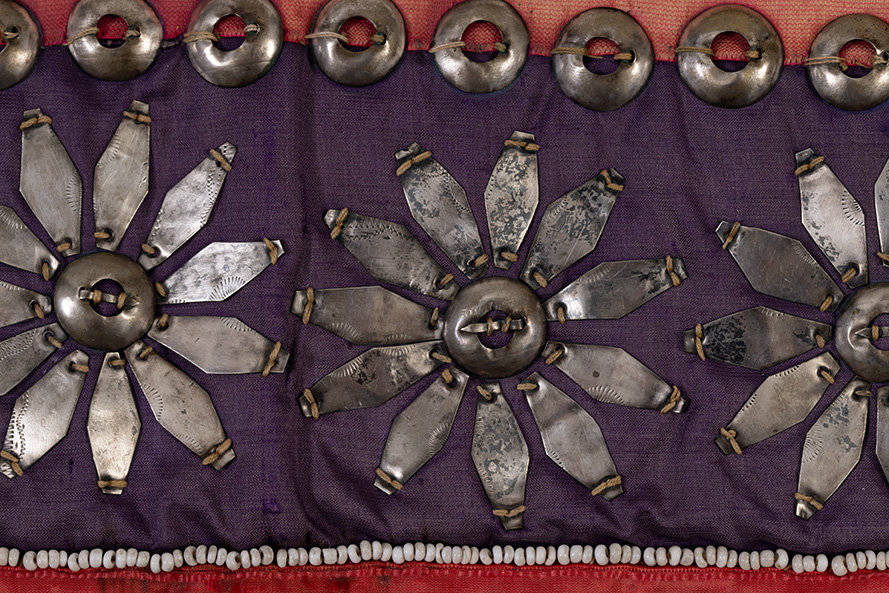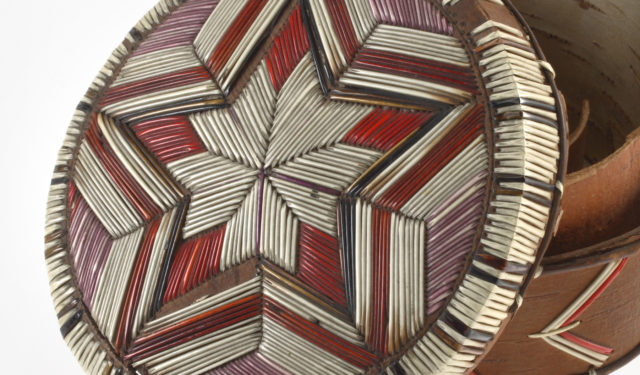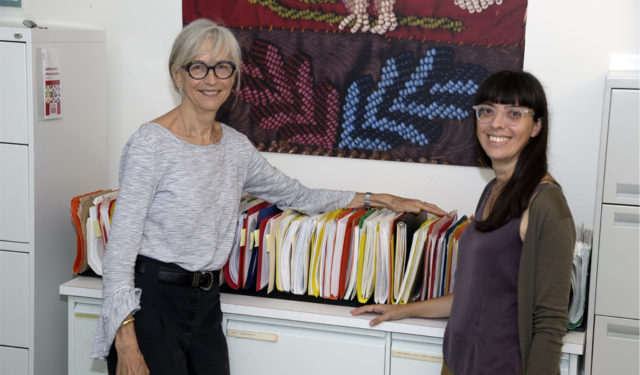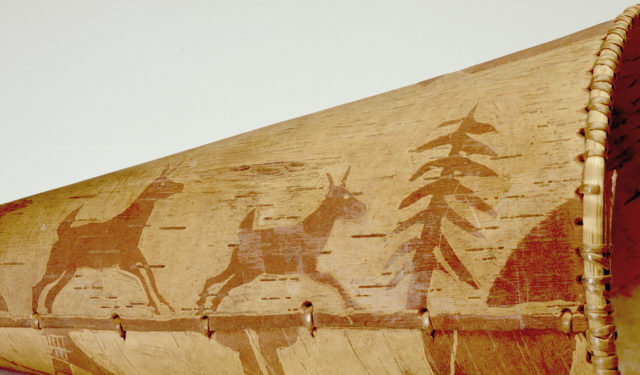Learning Care: Thoughts from a Conservation Intern
See how treating a cradleboard wrapper involved challenging technical and ethical considerations.
September 14, 2023
As part of my master’s degree in Art Conservation at Queen’s University, I had the privilege of completing an internship in the McCord Stewart Museum conservation laboratory. Under the supervision of conservators Sara Serban and Caterina Florio, I participated in the examination and treatment of artefacts for exhibition, maintenance of objects on display, and other departmental activities. In the treatment of one object in particular—a beautifully embellished silk and wool cradleboard wrapper—I faced a convergence of challenging technical and ethical considerations.
The cradleboard wrapper had been chosen for the yearly rotation of objects displayed in Indigenous Voices of Today: Knowledge, Trauma, Resilience, a permanent exhibition highlighting the Museum’s extensive Indigenous Cultures collection. Before being put on exhibition, the object required examination and treatment, which is why it arrived on my workbench.
For centuries and to this day, cradleboards have been used by Indigenous communities to carry and protect babies while freeing the caretaker’s hands. They typically consist of a thin wooden plank and swaddling material and decorative textiles to secure the infant to the board.1
Given its embellishments, we can infer that the cradleboard wrapper I was working on was the final textile to be wrapped around once the baby was secured to the board. We have little information about the object. Dated between 1840 and 1900, it is attributed to the Haudenosaunee people, though its maker is unknown. As Jonathan Lainey, curator of the Indigenous Cultures collection writes,
“[N]ot knowing about an object is also part of its story. […]. It reveals the methods of the collecting processes and the ways in which we have treated these items at some point in time.”2
Although some object’s files are sparse due to previous collecting practices, they themselves hold precious information which can still be gleaned. It is thus imperative that artefacts are properly cared for and that degradation is mitigated, so that they are available to present and future generations. This care is the work that we aspire to in conservation.
Intricate and detailed, the piece in front of me impressed with its artisanship. Composed of a black woolen stroud onto which ribbons of blue, pink, purple, red, green and mauve silk have been sewn with simple white beadwork, it is decorated with individual oval and circular silver ornaments arranged in triangle, flower, and star motifs.
These are trade-silver brooches, exchanged by Europeans during the fur trade period. Scholars have noted that the quantity of these brooches on Haudenosaunee garments conveys a sense of wealth and social status.3 With this embellishment, the cradleboard wrapper was made to be remarkable, and the contrast of the silver against the colourful ribbons would have indeed been striking when the object was first fashioned.
Likely crafted by a mother, relative, or family friend,4 the wrapper’s primary function was care: hold the baby safely against the cradleboard, keep it warm and provide a beautiful environment for its first months in the world. Now in the collection of the Museum, the object itself was in need of care.
The cradleboard wrapper was in relatively fair condition. Like all objects, it bore some signs of time passing. The silver had tarnished to a dark grey, losing most of its shine. The silk had embrittled, splitting and shattering in its most vulnerable areas, and the dyes had faded unevenly. Some of the metal brooches were loose on the textile. There was a loss in the decorative beadwork.
The composite nature of the object presented technical challenges as its different parts required different kinds of care. For instance, the metal brooches were at risk of falling off if not secured by stitching with new thread. However, the adjacent deteriorated silk would be vulnerable to further damage by the manipulation required for this stitching.
Conservation decisions balance multiple factors including legibility, artist’s intention and deterioration’s impact. Our ethics compel us to intervene minimally, prioritize preventative care and aspire to always work in a reversible way.5 Conservation ethics and practice are evolving as museums reckon with the ways in which collections have come to be, their entanglement with colonialism and the urgency of access and/or repatriation.
Recognizing our position as temporary custodians for objects in a complex history of care and collecting—and, in my case, working as a non-Indigenous conservator–we strive to do the best for the object by doing the least to the object.
When part of a museum collection, a garment is separated from the people who made it and those whose ancestors may have worn it. As I studied the cradleboard wrapper, I could not tell with certainty if the wear on its ribbons was from snuggly wrapping an infant, or if the stain on the red silk was part of its story before or after entering the Museum. I could, however, learn from its artisanship and function about Indigenous ways of living and caring. Métis-Canadian scholar Sherry Farrell Racette writes:
“Moving these items [Indigenous garments held in museum collections] into the public space of exhibition is a gesture of reconciliation that recognizes their beauty and significance, offering viewers an opportunity to reconnect and learn. […] These garments are like elders, holding critical memories and important information within their fibres and in the seams of their construction.”6
Through continuous dialogue, research and documentation, the treatment of the cradleboard wrapper began. Splits in the silk ribbons were stabilized by placing a thin semi-translucent support patch on their reverse. The silver ornaments were secured through loose stitching with a thread toned to resemble the original. Aesthetic interventions minimized the appearance of areas of damage or deterioration: a small row of white seed beads was added to compensate for the loss in the beadwork and silver tarnish was reduced to reveal a brighter metal. Without feigning artifice, these interventions allow the viewer to take in the object without gravitating to the damage.7
Stabilization and aesthetic reintegration were completed for the cradleboard wrapper to allow safe display in a condition that conveyed its inherent beauty. After working on the artefact for a few months, I had prepared it for the exhibition space and come to the end of my summer placement at the McCord Stewart Museum. I am grateful for the many teachings of my supervisors, for every object I encountered, and particularly for my intimate time with the cradleboard wrapper. Its treatment propelled me out of the ‘safe’ environment of the classroom and challenged me to navigate care in the complex context of our social history museums, where objects carry our complicated histories.
NOTES
1. Kaweena Moutour, Elizabeth. “First Nations Cradleboards: An Enduring Heritage” in Nations to Nations: Indigenous Voices at Library and Archives Canada, 2021, accessed at https://indd.adobe.com/view/c3ed209a-be08-4e4a-a63d-0bff322c4457.
2. Lainey, Jonathan. “Telling the Stories of Objects in Museum Collections: Some Thoughts and Approaches” in Igloliorte, Heather L., and Carla Taunton, eds. The Routledge Companion to Indigenous Art Histories in the United States and Canada. New York, NY: Routledge, Taylor & Francis Group, 2022, 297.
3. McCord Museum of Canadian History, Moira T. McCaffrey, Sherry Farrell Racette and Guislaine Lemay. “Wearing Our Identity: The First People’s Collection.” Edited by Suzanne Sauvage. Montreal: McCord Museum. 2013, 68.
4. Kaweena Moutour, “First Nations Cradleboards.”
5. Canadian Association for Conservation of Cultural Property. Code of Ethics and Guidance for Practice. 2000 (reprinted 2009). See “Professional Standards in the Conservation of Cultural Property,” clauses #2, 7, 16.
6. Racette, Sherry Farrell. “What Do Garments Tell Us?” in Wearing our Identity: The First People’s Collection. Montreal: McCord Museum, 2013, 16-17.
7. This technique was inspired by Basilissi, Giulia, et al. “Evaluation of a Dry Method Using Erasers for Silver-Copper Alloy Tarnish Cleaning and Comparison with Traditional Methods.” JAIC. 2022. Vol. 26. No.2. 112-118.

